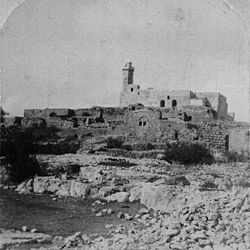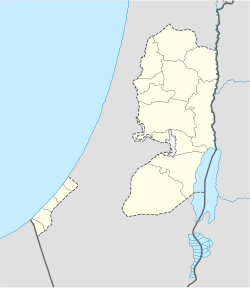- Nabi Samwil
-
an-Nabi Samwil Other transcription(s) – Arabic النبي صموئيل – Also spelled an-Nebi Samwil (official)
an-Nabi Samuil (unofficial)The village site in the early 20th century Location of an-Nabi Samwil within the Palestinian territories Coordinates: 31°49′57.84″N 35°10′48.54″E / 31.8327333°N 35.18015°ECoordinates: 31°49′57.84″N 35°10′48.54″E / 31.8327333°N 35.18015°E Governorate Jerusalem Government – Type Local Development Committee Area – Jurisdiction 1,592 dunams (1.6 km2 / 0.6 sq mi) Population (2006) – Jurisdiction 220 Name meaning "the prophet Samuel" An-Nabi Samwil also al-Nabi Samuil (Arabic: النبي صموئيل an-Nabi Samu'il, translit: "the prophet Samuel") is a Palestinian village of nearly 220 inhabitants in the West Bank, within the Jerusalem Governorate, located four kilometers north of Jerusalem. The village consists of a few houses and in addition to serving worshipers, its mosque acts as a prominent landmark.
Contents
Geography
Nabi Samwil is situated atop of a mountain, 890 meters above sea level, four kilometers north of the Jerusalem neighborhood Shuafat and southwest of Ramallah in the Seam Zone.[1] Nearby localities include Beit Iksa to the south, al-Jib to the north, Beit Hanina to the east and Biddu to the west.[2] The village consists of 1,592 dunams of which only dunams are built-up.[3]
History
See also: Tomb of SamuelThe village is traditionally held to contain the tomb of the prophet Samuel (Arabic: Nabi Samwil),[1][4] from which the village receives its name. The tomb is draped by cloth and is located in a dark cellar in Nabi Samwil's large turreted mosque. A monastery was built by the Byzantines at Nabi Samwil, serving as a hostel for Christian pilgrims on their way to Jerusalem. The monastery was restored and enlarged during the reign of Justinian I in the mid-6th century CE.[5] Since then, the site has been a place of pilgrimage for Jews, Christians and Muslims alike.[1] The tomb continued to be in use throughout the early Arab period of rule in Palestine from the 7th to 10th centuries.[5]
Jerusalem-born geographer al-Muqaddasi recounted in 985 CE, a story which he had heard from his uncle concerning the place: A certain Sultan wanted to take possession of the Dayr Shamwil, which he describes as a village about a farsakh from Jerusalem. The Sultan asked the owner to describe the village, at which the owner enumerated the ills of the place ("hard is the labour,/the profit is low./Weeds are all over,/almonds are bitter,/one bushel you sow,/one bushel you reap;") After hearing this the ruler exclaimed "Begone! We have no need for your village!"[6] 13th century Syrian geographer Yaqut al-Hamawi, describes "Mar Samwil" or "Maran Samwil" as a "a small town in the neighbourhood of Jerusalem. Mar in Syriac signifies al-Kass, 'the priest', and Samwil is the name of the Doctors of Law."[7] During Islamic times, Nabi Samwil became center for pottery production,[8] supplying nearby Jerusalem, as well as Ramla and Caesarea.[9]
In 1099, the Crusaders conquered Palestine from the Arab Fatimids and received their first view of Jerusalem from the mountain on which Nabi Samwil is built upon, thus naming it Mont de Joie ("Mountain of Joy"). They soon constructed a fortress there to fend off Muslim raiding of Jerusalem's northern approaches as well as to shelter pilgrim convoys.[5] A sixth-century Christian author identified the site as Samuel's burial place, and it has been traditionally been associated as such by Jews, Christians and Muslims. According to the Bible, however, the prophet is buried at his hometown, Ramah,[10] to the east of the hill which is located near Geba while this site is identified as Mizpah in Benjamin. As Judas Machabeus, preparing for war with the Syrians, gathered his men "to Maspha, over against Jerusalem: for in Maspha was a place of prayer heretofore in Israel".[11] The 12th century Jewish traveler Benjamin of Tudela visited the site when he traveled the land in 1173, noting that the Crusaders had found the bones of Samuel in a Jewish cemetery in Ramla on the coastal plain and reburied here, overlooking the Holy City. He wrote that a church dedicated to St. Samuel of Shiloh had been built on the hill.[12] This may refer to the abbey church of St. Samuel built by Premonstratensian canons and inhabited from 1141 to 1244.[13] In 1157, they constructed a church at Samuel's tomb.[1] The Crusader church was incorporated into the village mosque,[1] built in 1730 under the Ottoman Empire.[5] King Baldwin II of the Latin Kingdom of Jerusalem entrusted Nabi Samwil to Cistercians religious order, who built a monastery there and then handed it over to the Premonstratensians in the 1120s.[8] After the Ayyubids under Saladin conquered much of interior Palestine in 1187, the church and monastery were turned into a mosque and since then remained in Muslim hands. in 1192, Richard the Lionheart reached Nabi Samwil, but did not take it.[14]
In the 15th century, Jews built a synagogue adjacent to the mosque and resumed pilgrimages to the site after losing that privilege during the Crusader era. In the 16th century, the Jews were forced to give up some of their privileges there, but by the 18th century Jewish pilgrimage to Nabi Samwil was restored. Mujir ad-Din referring to Jerusalem's size writes "From the north it reaches the village wherein is the tomb of the prophet Shamwil, may Allah bless him and give him peace."[15]
Nabi Samwil was heavily damaged by Turkish shells in 1917 while fighting British forces, but the village was rebuilt and resettled in 1921.[16] The Ottoman mosque which was destroyed was restored by the Supreme Muslim Council during the British Mandate era.[4][5] On April 23, 1948, during the 1948 Arab-Israeli War, a Palmach division attacked Nabi Samwil with the intention of capturing the village for Israel. The operation failed, since its local defenders had been notified that nearby Beit Iksa was attacked and thus, prepared for a Jewish assault. Over 40 Palmach troops were killed in the battle with minimal Arab casualties.[17]
From 1948 to 1967, Nabi Samwil was used by the Arab Legion of Jordan as a military post guarding access to Jerusalem, until it was occupied by Israel in the Six-Day War.[1] In March 1971, several illegally constructed homes were demolished. [18]
Demographics
In 1922, Nabi Samwil had 121 inhabitants, rising to 138 in 1931. In Sami Hadawi's land and population survey in 1945, 200 people resided there. By 1981, the number dropped to 66 inhabitants but was up to 136 within five years.[3] According to the Palestinian Central Bureau of Statistics, Nabi Samwil had a population of 219 inhabitants in mid- 2006.[19] A total of 20 Muslim families live there. A group of 90 Bedouins living in al-Jib who had been evicted from Nebi Samuel were refused permission to move back because the village lies in Area “C” and it would be difficult for them to acquire building permits.[20]
References
- ^ a b c d e f Jacobs, Daniel. (1998). Israel and the Palestinian territories. Rough Guides, p.429.
- ^ Satellite View of al-Nabi Samwil
- ^ a b Welcome to al-Nabi Samwil Palestine Remembered.
- ^ a b Nabi Samuel - Jerusalem Jerusalem Media and Communications Centre.
- ^ a b c d e Nebi Samwil - Site of a Biblical Town and a Crusader Fortress Israeli Ministry of Foreign Affairs. 2001-09-01.
- ^ Al-Muqaddasi (Basil Anthony Collins (Translator)): The Best Divisions for Knowledge of the Regions. Ahasan al-Taqasim Fi Ma'rifat al-Aqalim. Garnet Publishing, Reading, 1994, ISBN 1873938144, p. 171, (orig. p.188). Older translation is given in Le Strange, Guy: Palestine under the Moslems. London, 1890. p. 433, (orig. p.188)
- ^ Le Strange, Guy: Palestine under the Moslems. London, 1890. p.433 (orig. Yak., iv. 391; Mar., iii.29)
- ^ a b Sharon, 1995, p.118.
- ^ Sharon, 1995, pp.122-123.
- ^ (1Samuel 25:1, 28:3)
- ^ I Mach., iii, 46, cited in
 "Maspha". Catholic Encyclopedia. New York: Robert Appleton Company. 1913.
"Maspha". Catholic Encyclopedia. New York: Robert Appleton Company. 1913. - ^ Travelling to Jerusalem-Benjamin of Tudela
- ^ Summary Page: Palestine/Israel (Kingdom of Jerusalem)-St. Samuel
- ^ Sharon, 1995, p.119
- ^ Sharon, 1995, pp.119-120.
- ^ Jerusalem Won at Bayonet's Point New York Times. 1917-12-17.
- ^ Tal, David. (2003). War in Palestine, 1948: Strategy and Diplomacy Routledge, p.118.
- ^ Israeli occupation forces demolish the village of Nabi Samuil Mahsanmilim. September 2008.
- ^ Projected Mid -Year Population for Jerusalem Governorate by Locality 2004- 2006 Palestinian Central Bureau of Statistics.
- ^ Protection of Civilians Weekly Report United Nations Office for the Coordination of Humanitarian Affairs, p.7. January 2008.
External links
- Israel severs a-Nabi Samwil Village from rest of the West Bank, B'Tselem
- Battle of Nebi Samwil
Jerusalem Governorate Municipalities 

Villages 'Anata · 'Arab al-Jahalin · Beit 'Anan · Beit Duqqu · Beit Hanina · Beit Iksa · Beit Safafa · Beit Surik · Jaba' · al-Jib · al-Judeira · Kalandia · Mikhmas · Nabi Samwil · al-Qubeiba · Rafat, Jerusalem · as-Sawahira ash-Sharqiya · Sharafat · ash-Sheikh Sa'd ·
az-Za'ayyemRefugee camps
Categories:- Jerusalem Governorate
- Villages in the West Bank
- Archaeological sites in the West Bank
- Buildings and structures in the West Bank
- Ziyarat
Wikimedia Foundation. 2010.


